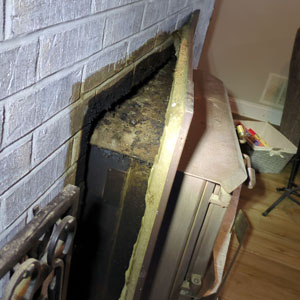Unlined Inserts
What do you need to know?
Understanding the risks of unlined inserts
Historically, it was a typical practice for homeowners (dating back 20-40 years) to install an insert into an already existing open fireplace. They would then conceal the space between the insert and the original fireplace with decorative trim, often filling it with insulation to block cold drafts or smoke backflows. However, this approach, while generating more heat compared to an open fireplace, unfortunately leads to various issues and increases the likelihood of chimney fires.
Greater danger of chimney fires
The design of the insert or stove is such that it generates a specific amount of smoke to create the right draft in a chimney, the size of which is determined by the diameter of the insert’s top collar, typically 6-8 inches, equivalent to a flue cross-sectional area of 28-50 square inches. In the absence of a 6”-8” stainless steel liner extending from the insert to the chimney top, the smoke is released into a substantially larger space. Initially, the smoke fills the fireplace chamber, then moves to the smoke chamber above the damper, and finally reaches the clay flue tile chimney, generally measuring 8”x13” to 13”x17”, or 104 – 221 square inches in cross-sectional area.
This means the smoke travels through a space about four times larger than intended, offering more surface area for creosote accumulation. The effect is similar to having a chimney four times its actual length, leading to longer residence time for the smoke, allowing unburned carbon particles to cool, combine with water vapor, and form creosote on the chimney walls. More creosote equates to a higher risk of chimney fires, where temperatures can rapidly soar to 2100 degrees Fahrenheit. Such intense heat can cause the terracotta flue tiles to expand quickly, potentially cracking and splitting them, thus posing a significant fire risk to the house.
Challenges presented in cleaning unlined inserts
Cleaning an unlined system is a highly laborious process. It involves taking off the trim, extracting the insert, and cleaning the firebox, smoke chamber, and chimney, followed by putting the insert back in place. This extensive work can take over three hours and potentially double the cleaning costs. Consequently, some dishonest chimney sweeps might skip removing the insert during cleaning, leading to a significant buildup of creosote atop the insert, creating a dangerous situation akin to a ticking bomb, ready to cause a chimney fire. This leaves homeowners with a misguided sense of security, believing that regular sweeping ensures safety, unaware of the lurking danger.
Historically, the most significant damage observed in chimneys, such as cracked flue tiles, severe creosote glazing, and signs of chimney fires, have predominantly been in systems with unlined wood-burning inserts. In fact, issues like creosote buildup and chimney fires are notably more prevalent in systems with unlined inserts compared to those in open fireplaces without any inserts.
Solutions
Installing a correctly sized and insulated liner typically costs around $1500 to $2000. However, connecting a liner to an outdated, inefficient, non-EPA certified insert is often neither legal nor sensible. Flame Masters does not install units that lack EPA certification. Additionally, the inefficient combustion in non-EPA certified units can harm the liner, leading to frequent clogging and reducing the lifespan of your investment.
The optimal solution is to fully reline your chimney and connect it to an EPA-certified appliance. This approach not only resolves the issue but also brings several benefits, including:
- A fully sealed firebox for safety
- Higher efficiency and user-friendliness
- Reduced wood usage with fewer reloads
- Enhanced ambiance through ceramic glass doors
- Improved heat distribution with built-in blowers
- Significantly less pollution, reducing emissions to approximately 5 grams per hour compared to more than 50 grams per hour


